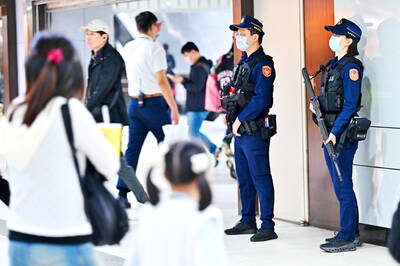South Korea's first bullet train goes into service this week promising to transform people's lives by easing chronic traffic congestion.
After 14 trillion won (US$12 billion) of investment and years of delay caused by the 1997 Asian financial crisis and major engineering obstacles, the 300kmh train will open for business on Thursday on two lines linking Seoul to Busan in the southeast and Mokpo in the southwest.

PHOTO: AFP
The construction of the new rail system, dubbed Korea Train Express (KTX), is considered a seminal national event here, on a par with the completion of South Korea's first highway from Seoul to Busan, 428km south, in 1970.
Many more highways have been added since then, but road-building was overtaken by the number of vehicles in the intervening years, leaving South Korea's transport costs among the highest in the world.
Kim Se-Ho, head of the state-run Korean National Railroad (KNR), said KTX would bring about "revolutionary changes to logistics and people's lives."
"By mixing KTX with other means of transportation, you can reach anywhere in the country within a half day," he said of the French technology-based bullet train.
Lifestyles will improve as people abandon congested cities for the countryside in search of cheaper rent and clean air and residents in provincial cities will be able to shop and see art performances in Seoul, he said.
Commuters will take 49 minutes travelling by train between Seoul and Daejeon, some 160km south, while motorists sit behind the wheel for more than an hour to reach downtown from the outskirts of the capital.
KTX covers the whole 410km run from Seoul to Busan in 160 minutes although it has to slow down on old tracks used by conventional trains.
The fastest conventional train covers the same distance in 240 minutes.
When the old tracks yield to new railbeds in 2010, the travel time will be cut to 116 minutes.
In its first year of service, KTX is expected to carry 180,000 passengers per day, enabling the Korean National Railway to cut back on slower services to free up those trains for cargoes.
Experts said the costs of road traffic congestion in South Korea have been increasing 13.5 percent on average over the past 10 years to hit 22 trillion won in 2002.
It amounts to 3.7 percent of the country's total GDP.
"KTX is equal to four Seoul to Busan highways in terms of logistics capacity," Kim said, adding that KTX will save the country 1.85 trillion won in logistics cost next year alone.
Aside from logistical gains, the new railway system brought a leap forward to South Korea's railway technology.
KTX will operate 46 sets of trains, 12 imported directly from Alstom of France and 34 others were assembled here.
With technology transfer from Alstom, KNR has successfully developed its own model, the G7.
"We plan to increase G7's speed to 350 kilometers per hour," Kim said, adding that South Korea seeks to export this model.
KTX recently took a group of diplomats and journalists on a test driving to Daejeon. The sleek silver-grey and blue train hit 307km at one point but passengers reported slightly more rolling and noise than the France's TGV high-speed train.
Acting President Goh Kun expressed hope on Wednesday that KTX would help South Korea emerge as a railway hub on the "Iron Silk Road" linking Northeast Asia and the Pacific to Europe.
"My dream is to travel to Pyongyang and all the way across Siberia to Europe by this high-speed train," Kim said.

TRAGEDY STRIKES TAIPEI: The suspect died after falling off a building after he threw smoke grenades into Taipei Main Station and went on a killing spree in Zhongshan A 27-year-old suspect allegedly threw smoke grenades in Taipei Main Station and then proceeded to Zhongshan MRT Station in a random killing spree that resulted in the death of the suspect and two other civilians, and seven injured, including one in critical condition, as of press time last night. The suspect, identified as a man surnamed Chang Wen (張文), allegedly began the attack at Taipei Main Station, the Taipei Fire Department said, adding that it received a report at 5:24pm that smoke grenades had been thrown in the station. One man in his 50s was rushed to hospital after a cardiac arrest

SAFETY FIRST: Double the number of police were deployed at the Taipei Marathon, while other cities released plans to bolster public event safety Authorities across Taiwan have stepped up security measures ahead of Christmas and New Year events, following a knife and smoke bomb attack in Taipei on Friday that left four people dead and 11 injured. In a bid to prevent potential copycat incidents, police deployments have been expanded for large gatherings, transport hubs, and other crowded public spaces, according to official statements from police and city authorities. Taipei Mayor Chiang Wan-an (蔣萬安) said the city has “comprehensively raised security readiness” in crowded areas, increased police deployments with armed officers, and intensified patrols during weekends and nighttime hours. For large-scale events, security checkpoints and explosives

PUBLIC SAFETY: The premier said that security would be tightened in transport hubs, while President Lai commended the public for their bravery The government is to deploy more police, including rapid response units, in crowded public areas to ensure a swift response to any threats, President William Lai (賴清德) said yesterday after a knife attack killed three people and injured 11 in Taipei the previous day. Lai made the remarks following a briefing by the National Police Agency on the progress of the investigation, saying that the attack underscored the importance of cooperation in public security between the central and local governments. The attack unfolded in the early evening on Friday around Taipei Main Station’s M7 exit and later near the Taipei MRT’s Zhongshan

A car bomb killed a senior Russian general in southern Moscow yesterday morning, the latest high-profile army figure to be blown up in a blast that came just hours after Russian and Ukrainian delegates held separate talks in Miami on a plan to end the war. Kyiv has not commented on the incident, but Russian investigators said they were probing whether the blast was “linked” to “Ukrainian special forces.” The attack was similar to other assassinations of generals and pro-war figures that have either been claimed, or are widely believed to have been orchestrated, by Ukraine. Russian Lieutenant General Fanil Sarvarov, 56, head